Equipment/Hitachi VC-6545: Difference between revisions
From London Hackspace Wiki
m (image) |
m (Formatting.) |
||
| (5 intermediate revisions by the same user not shown) | |||
| Line 20: | Line 20: | ||
We have two of these. | We have two of these. | ||
Archive.org [https://archive.org/details/hitachi_VC-6025-6045-6525-6545-Service_Manual-complete Online Manual (with PDF download)] and [https://archive.org/stream/hitachi_VC-6025-6045-6525-6545-Service_Manual-complete/VC-6025-6045-6525-6545-Service_Manual-complete_djvu.txt Alternate Searchable Full Text Version] | |||
Specs: | |||
40MS/s(1CH), | |||
20MS/s(2CH simultaneously), | |||
100MHz Bandwidth, 4kword(1CH), 2kw/CH, | |||
Delayed Sweep, Frequency counter. | |||
'''Features''' | |||
* Retro-Cool CRT-based Vector Screen showing Basic Real-time & Storage Oscilloscope | |||
* Exclusive one-shot and intermittent phenomena are simple to capture using the digital storage function. | |||
* Using the pre-trigger function, it is possible to observe the rising edge of a waveform which occurs before the trigger occurs. | |||
* Non-repeating events can be observed as clean waveform using the digital storage function. | |||
* Low-speed phenomena can be observed as a trace using the digital storage function (roll mode). | |||
* External plotter functionality enables hardcopies of CRT waveform data. | |||
* Averaging can be used to reduce noise, providing summary signal of interest. | |||
* Captured waveform can be saved to internal memory and recalled for comparison. | |||
* RS-232C serial interface usable to transfer stored waveform data. | |||
* Dual cursors can be enabled to make accurate measurements of voltage, time, and frequency. | |||
* After waveform capture, it can be displayed in expanded form with interpolation (linear or sine). | |||
* Using sweep time auto-ranging, the sweep rate setting automatically optimised in accordance with the input signal frequency. | |||
* Trigger lock hold the sum of the hold-off time and sweep time for stable trigger of complex pulse trains. | |||
* Frequency of the channel selected as the trigger signal is automatically counted. | |||
'''Example video of similar Hitachi scope functions demonstrated''' | |||
{{#ev:youtube|ZQLZ6WhMB7o}} | |||
Latest revision as of 23:35, 2 January 2019
Hitachi VC-6545 CRT Storage Oscilloscope
We have two of these.
Archive.org Online Manual (with PDF download) and Alternate Searchable Full Text Version
Specs:
40MS/s(1CH), 20MS/s(2CH simultaneously), 100MHz Bandwidth, 4kword(1CH), 2kw/CH, Delayed Sweep, Frequency counter.
Features
- Retro-Cool CRT-based Vector Screen showing Basic Real-time & Storage Oscilloscope
- Exclusive one-shot and intermittent phenomena are simple to capture using the digital storage function.
- Using the pre-trigger function, it is possible to observe the rising edge of a waveform which occurs before the trigger occurs.
- Non-repeating events can be observed as clean waveform using the digital storage function.
- Low-speed phenomena can be observed as a trace using the digital storage function (roll mode).
- External plotter functionality enables hardcopies of CRT waveform data.
- Averaging can be used to reduce noise, providing summary signal of interest.
- Captured waveform can be saved to internal memory and recalled for comparison.
- RS-232C serial interface usable to transfer stored waveform data.
- Dual cursors can be enabled to make accurate measurements of voltage, time, and frequency.
- After waveform capture, it can be displayed in expanded form with interpolation (linear or sine).
- Using sweep time auto-ranging, the sweep rate setting automatically optimised in accordance with the input signal frequency.
- Trigger lock hold the sum of the hold-off time and sweep time for stable trigger of complex pulse trains.
- Frequency of the channel selected as the trigger signal is automatically counted.
Example video of similar Hitachi scope functions demonstrated
{{#ev:youtube|ZQLZ6WhMB7o}}
